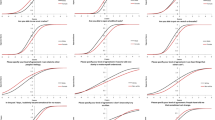Abstract
This report describes initial experience with a new self-report questionnaire, the 17 item Angina-related Limitations at Work Questionnaire. Forty employed individuals with chronic stable angina pectoris completed the questionnaire which retrospectively examined the subjects' difficulty in performing specific work activities during the preceding 4 week period. The questionnaire performed well in this study and there was initial evidence of its validity and reliability. More than one-half of the respondents (52.5%) indicated at least some difficulty in performing one or more of the 17 work items due to angina during the preceding 4 weeks, with the greatest difficulty experienced in physically exerting tasks, handling stressful situations and feeling a sense of accomplishment. In contrast, only one-quarter of the sample missed any work time. In tests of convergent validity, the degree of work limitation correlated significantly with SF-36 physical and mental health component scores and with self-reports of angina symptoms. The questionnaire had internal reliability, with item to total score correlations of 0.75 or higher for 14 of the 17 items. In summary, the Angina-related Limitations at Work Questionnaire offers promise for quantifying work limitations among individuals with chronic stable angina.
Similar content being viewed by others
References
Hoffman C, Rice D, Sung H-Y. Persons with chronic conditions: their prevalence and costs. JAMA 1996; 276: 1473–1479
Patrick DL, Erickson P. Health Status and Health Policy: Allocating Resources to Health Care. New York: Oxford University Press, 1993: 76–78.
LaPlante MP, Carlson D. Disability in the United States: Prevalence and Causes, 1992. Disability Statistics Report (7). Washington, DC: US Department of Education, National Institute on Disability and Rehabilitation, 1996.
American Heart Association. Heart and Stroke Facts: 1996, Statistical Supplement. Dallas, TX: American Heart Association National Center, 1996.
Wenger N, Furberg CD. Cardiovascular disorders. In: Spilker B, ed. Quality of Life Assessment in Clinical Trials. New York: Raven Press Ltd, 1990: 335–345.
Feinstein AR, Wells CK. A new clinical taxonomy for rating change in functional activities of patients with angina pectoris. Am Heart J 1977; 93(2): 172–182.
Goldman L, Hashimoto B, Cook F, Loscalzo A. Comparative reproducibility and validity of systems for assessing cardiovascular functional class: advantages of a new specific activity scale. Circulation 1981; 64: 1227–1234.
Dennis C, Goins P, DeBusk RF. Conspectus: working after heart attack. Comp Ther 1989; 15(11): 3–6.
Dimsdale JE, Hackett TP, Hutter AM, Jr, Block PC. The association of clinical, psychosocial, and angiographic variables with work status in patients with coronary artery disease. J Psychosomat Res. 1982; 26: 215–221.
Misra KK, Kazanchi BN, Davies GJ et al. Determinants of work capability and employment after coronary artery surgery. Eur Heart J. 1985; 6: 176–180.
Mark DB, Lam LC, Lee KL et al. Effects of coronary angio-plasty, coronary bypass surgery, and medical therapy on employment in patients with coronary artery disease. Ann Intern Med 1994; 120(2): 111–117.
Spertus JA, Winder JA, Dewhurst TA et al. Development and evaluation of the Seattle Angina Questionnaire: a new functional status measure for coronary artery disease. J Am Coll Cardiol 1995; 25: 333–341.
Ware JE, Jr, Snow KK, Kosinski M, Gandek B. SF-36 Health Survey Manual and Interpretation Guide. Boston, MA: The Health Institute, New England Medical Center, 1993.
Bush JW. General health policy model: Quality of Well-being Scale (QWB). In: Wenger N, Mattson ME, Furberg CD, Elinson J, eds. Assessment of Quality of Life in Cardiovascular Therapies. LeJacq, 1984: 189–199.
Bergner M, Bobbitt RA, Carter WB, Gilson BS. The Sickness Impact Profile: development and final revision of a health status measure. Med Care 1981; 19(8): 787–805.
Lerner DJ, Bungay KM. Measuring work outcomes. In: Bungay KM, Osterhaus JT, Paladino JA, Sanchez LA, eds. Pharmacoeconomics and Outcomes: Applications for Patient Care. Module 3: Assessment of Humanistic Outcomes. Kansas City, MO: American College of Clinical Pharmacy, 1997.
Rose GA. Ischemic heart disease: Chest Pain Questionnaire. Milbank Mem Fund Quart 1965; 43: 32–39.
Cronbach LJ. Coefficient alpha in internal structure tests. Psychometrika 1951; 16 297–334.
Shrout PE, Fleiss JL. Intraclass correlations: uses in assessing rater reliability. Psychol Bull 1979; 86: 420.
Burgess AW, Lerner DJ, D'Agostino RB et al. A randomized control trial of cardiac rehabilitation. Soc Sci Med 1987; 24:359–370.
Author information
Authors and Affiliations
Rights and permissions
About this article
Cite this article
Lerner, D.J., Amick, B.C., Malspeis, S. et al. The Angina-related Limitations at Work Questionnaire. Qual Life Res 7, 23–32 (1997). https://doi.org/10.1023/A:1008880704343
Issue Date:
DOI: https://doi.org/10.1023/A:1008880704343




